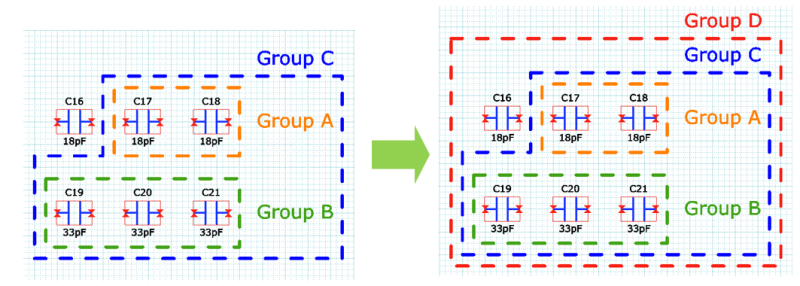The Group command is used to group objects on the canvas in eCADSTAR Schematic Editor or Symbol Editor. This allows you to move them as a single item. Select multiple relevant objects on the canvas, and then click Home > Move > Arrange > Group on the ribbon. Alternatively, right-click them and select Group on the assist menu. You can also press Ctrl+G on the keyboard to launch the command. The Undo or Redo commands allow you to undo or redo this command, respectively. Groups that you specify cannot be transferred to eCADSTAR PCB Editor. For further guidance on using groups, see Working with Groups
The following table shows the objects in eCADSTAR Schematic Editor that can and cannot be grouped.
| Grouped | Not Grouped | |
|---|---|---|
| Sheet Editor | Component | Net (including nodes and segments) |
| Line | Bus (including nodes and segments) | |
| Circle | Component Pin | |
| Area Fill | Property Viewer owned by non-sheet objects. | |
| Text | ||
| Frame | ||
| Sheet Settings | ||
| Symbol Editor | Symbol Pin | Property Viewer owned by non-sheet objects. |
| Line | ||
| Circle | ||
| Area Fill | ||
| Text | ||
| Sheet Settings |
Adding Child Groups to a Group
To create a group that holds child groups, select all members of each child group before executing the Group command. After adding a child group to a group, the child group cannot be selected. Only the parent group can be selected. In the following image, the parent group, Group C, contains the child groups Group A and Group B.

Adding Objects to a Group that Contains Child Groups
For groups that contain child groups, only the parent group can be selected. In the image below, Group A and Group B are child groups of Group C, but cannot be selected. You can create a new group by selecting C16 and Group C. However, you cannot create a new group by selecting C16 and either Group A or Group B.

The display on the canvas is not changed when objects are grouped using this command. Also, the attributes of groups are not shown in the Object Balloon or Properties Panel

